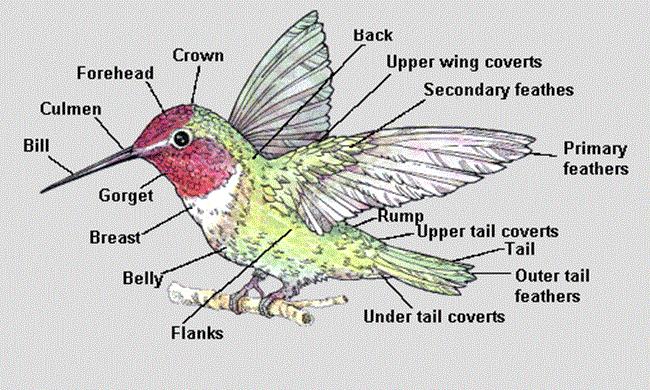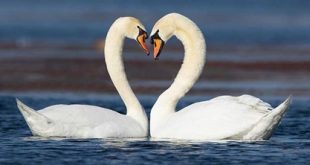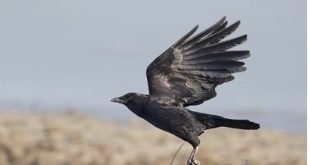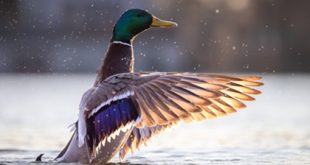Hummingbirds are among the most fascinating creatures in the avian world. These tiny birds, known for their vibrant plumage and astonishing aerial abilities, have specialized body parts that enable them to perform incredible feats. Each part of their body is uniquely adapted to support their high-energy lifestyle. Let’s explore the key body parts of hummingbirds and their functions in detail.
A Body Parts Of Hummingbird

1. Beak
The beak of a hummingbird is long, slender, and slightly curved, perfectly adapted for feeding on nectar from flowers. This specialized beak allows the bird to reach deep into tubular flowers to access the nectar that serves as its primary energy source. Additionally, hummingbirds also use their beaks to catch small insects and spiders, which provide essential proteins.
Function:
- Extracting nectar from flowers.
- Capturing insects and spiders for protein.
- Assisting in grooming and nest-building activities.
2. Tongue
A hummingbird’s tongue is a marvel of biological engineering. It is long, bifurcated (split at the tip), and lined with tiny hair-like structures called lamellae. When feeding, the tongue extends far beyond the beak and curls around nectar in a rapid lapping motion, using capillary action to draw the liquid into its mouth.
Function:
- Collecting and transporting nectar from flowers to the throat.
- Facilitating efficient and rapid feeding to meet high energy demands.
3. Eyes
Hummingbirds have large, round eyes that provide excellent vision. Their eyes are positioned on the sides of their heads, giving them a wide field of view. They possess a high density of cone cells in their retinas, allowing them to perceive a broader spectrum of colors, including ultraviolet light. This ability helps them locate flowers and recognize mates or rivals.
Function:
- Detecting bright colors and flower patterns.
- Spotting predators and navigating through complex environments.
- Enhancing depth perception during high-speed flight.
4. Wings
The wings of a hummingbird are a key component of their extraordinary flying ability. Unlike most birds, hummingbirds can rotate their wings in a full circle, allowing them to hover in place, fly backward, and even upside down. The wings are powered by robust pectoral muscles, which make up about 30% of the bird’s body weight.
Function:
- Enabling precision hovering and multidirectional flight.
- Supporting sustained high-speed flight, often reaching 30 miles per hour during regular movement and up to 60 miles per hour during courtship dives.
5. Tail
A hummingbird’s tail consists of a set of feathers that fan out and provide stability during flight. The tail feathers also play a role in courtship displays, where males often fan their tails to show off their vibrant colors. Additionally, the tail acts as a rudder, aiding in steering and braking.
Function:
- Providing stability and balance during flight.
- Assisting in rapid directional changes and braking.
- Playing a role in mating displays to attract partners.
6. Feet
Unlike their wings, a hummingbird’s feet are relatively small and weak. These birds do not walk or hop like other birds but use their feet primarily for perching. The feet also aid in grooming and scratching, as well as gripping during brief rests.
Function:
- Perching on branches or feeders.
- Grooming feathers to maintain hygiene and flight efficiency.
7. Heart
The heart of a hummingbird is proportionally the largest of any bird species, accounting for about 2.5% of its body weight. It beats at an astonishing rate, ranging from 250 beats per minute at rest to over 1,200 beats per minute during flight. This rapid heartbeat pumps oxygen-rich blood to the muscles and organs, sustaining their high metabolism.
Function:
- Circulating oxygen and nutrients throughout the body.
- Supporting the bird’s incredibly high energy demands during flight.
8. Brain
Hummingbirds have relatively large brains for their body size, which are highly developed to support their complex behaviors. They have excellent spatial memory, allowing them to remember the locations of flowers and feeders as well as the timing of nectar replenishment.
Function:
- Coordinating flight patterns and feeding behaviors.
- Storing spatial and temporal information about food sources.
- Facilitating learning and problem-solving skills.
9. Feathers
Hummingbirds are adorned with iridescent feathers that shimmer in vibrant colors. The iridescence is due to microscopic platelets in the feathers that reflect and refract light. These feathers are not just for display but also provide insulation and aid in aerodynamics.
Function:
- Attracting mates through colorful displays.
- Providing insulation to maintain body temperature.
- Enhancing aerodynamic efficiency during flight.
10. Respiratory System
Hummingbirds have an efficient respiratory system that supports their high metabolic rate. Their lungs are complemented by air sacs that store oxygen and help in continuous breathing, even during the intense activity of flight.
Function:
- Facilitating efficient oxygen exchange to sustain high energy levels.
- Supporting prolonged periods of hovering and rapid wing movement.
11. Skeleton
The skeleton of a hummingbird is lightweight yet strong, with fused bones in areas like the shoulder to support the vigorous motion of their wings. Their keel bone is particularly large, providing ample surface area for the attachment of powerful flight muscles.
Function:
- Providing structural support while minimizing weight.
- Anchoring muscles needed for high-intensity flight.
Conclusion
Every part of a hummingbird’s body is meticulously designed to support its energetic lifestyle. From their specialized beaks and tongues for feeding to their powerful wings and efficient respiratory system, these birds are a testament to nature’s ingenuity. Understanding the anatomy and functions of hummingbirds not only highlights their remarkable adaptations but also underscores the importance of protecting their habitats to ensure their survival. By appreciating the intricate details of their biology, we can gain a deeper respect for these incredible creatures.


